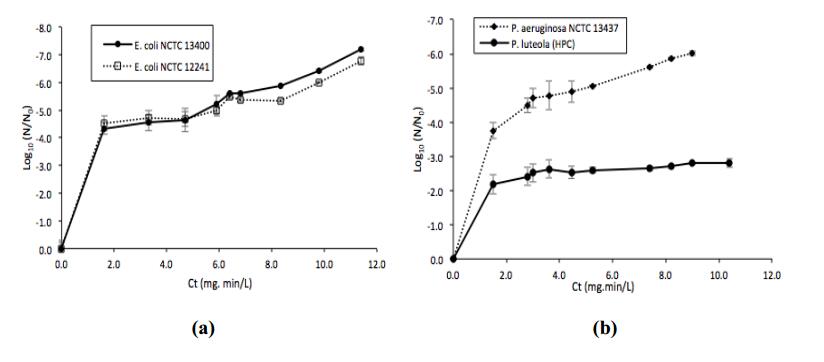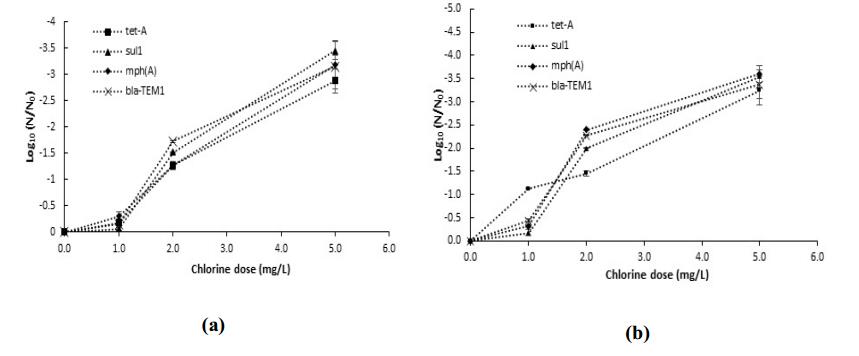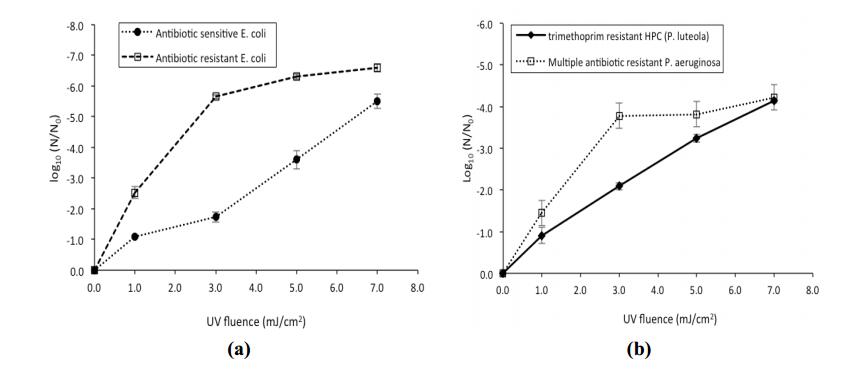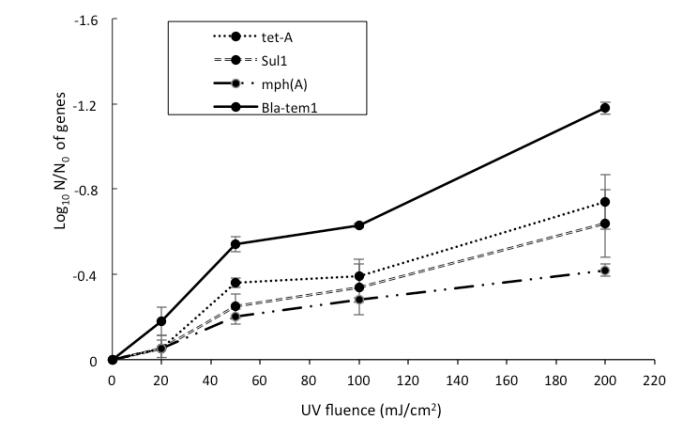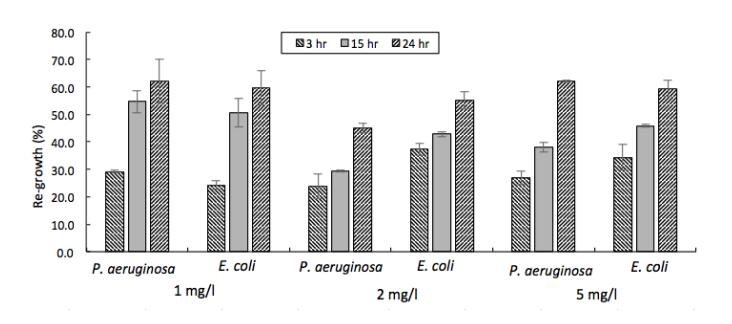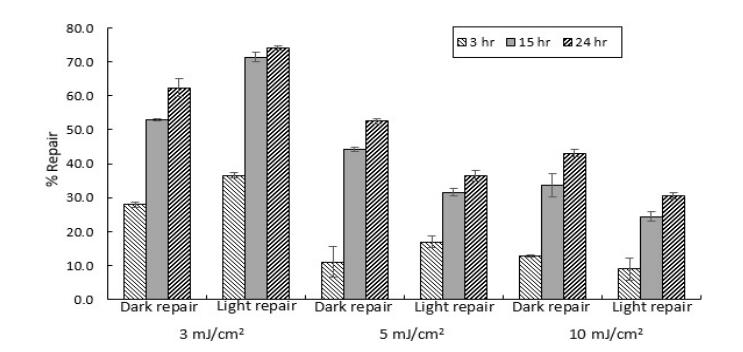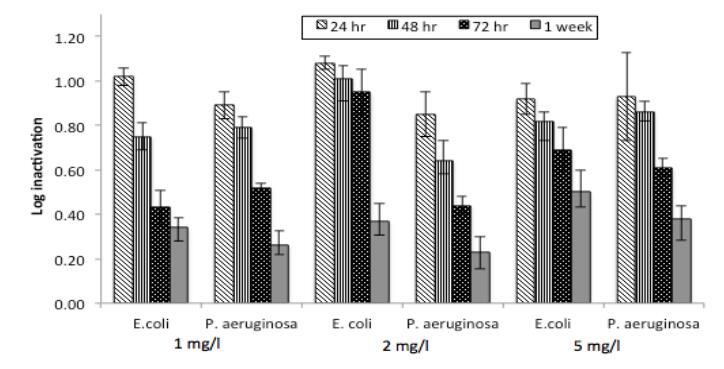This study determined the effectiveness of chlorine, UV and combination of UV/chlorine in inactivating antibiotic-resistant bacteria (ARB) and antibiotic resistance genes (ARG), as well as potential repair of these bacteria following disinfection processes in drinking water. Previous studies have assessed the efficacy of UV disinfection in inactivating ARBs, however, most of these studies have focused on wastewater treatment applications. The use of chlorine and UV disinfection at typical drinking water industry doses was found to not completely eliminate the resistance genes. Using 30 mg/min/L of chlorine, the inactivation of tet(A), bla- TEM1 , sul1, mph(A) was 1.7-log, while a UV fluence of 200 mJ/cm 2 only resulted in a reduction of up to 1.2-log of these genes. This suggests that these genes can continue to be present in distribution systems even following disinfection. On the other hand, the application of sequential UV disinfection followed by chlorination significantly reduced the ARGs and had synergistic effects compared to single disinfectant use, with a resulting synergy in the inactivation achieved (log units) ranging between 0.01 and 0.62-log across the tested ARGs . The ARBs also demonstrated the potential for re-growth following chlorination up to 5 mg/L and UV disinfection of up to 10 mJ/cm 2 under the conditions of this study.
1.
Introduction
Recent studies have shown that a variety of antibiotic resistant bacteria (ARBs) and genes (ARGs) occurr in drinking water t around the world [1,2,3]. This suggests that drinking water treatment processes are unable to completely remove ARBs and ARGs from water. Furthermore, intact fragments of DNA may confer resistance to downstream bacteria by horizontal gene transfer, and injured ARB can be fully re-activated and retain their resistance [4,5,6]. Horizontal gene transfers consists of three mechanisms: (1) conjugation, which requires contact between cells via cell surfaces or adhesion through which DNA is then transferred, (2) transformation, which is the uptake of naked fragments of extracellular DNA, and (3) transduction, which requires bacteriophage to transfer the DNA. These mechanisms allow resistance to spread between non-pathogenic bacteria and pathogenic or potentially pathogenic bacteria, extending the resistance even further [6,7].
Chlorination has historically been the primary disinfection method used in drinking water treatment due to its low cost, relative ease of application and ability to inactivate a wide range of pathogens. It is a non-selective oxidant that is employed due to its vigorous reactions with different cellular components and its ability to interrupt bacterial metabolic processes [8]. Studies have shown that chlorine at high doses (i.e. > 20 mg/L) were able to reduce resistance genes sul1, tetG, intl1, tetX [9,10]. However, some antibiotic-resistant bacteria have been reported to demonstrate resistance to chlorine [11].
Studies on UV disinfection of antibiotic resistant bacteria and genes have been conflicting in their findings; for instance, one study reported that there was no statistically significant difference in UV-resistance between ampicillin resistant E. coli and antibiotic sensitive E. coli [12]. On the other hand, UV disinfection has been suggested to potentially cause enrichment of resistant bacteria [13]. Additionally, it is known that common disinfectants such as chlorination and UV might alter the structure of bacterial communities in drinking water systems [13,14]. It has been reported that UV disinfection increases bacterial resistance toward sulfadiazine, vancomycin, rifampicin, tetracycline and chloramphenicol [15]. Furthermore, UV-inactivated cells might regain viability through repair mechanisms, e.g. by photoreactivation through simultaneous or subsequent exposure to near-UV and visible light (300–500 nm), often called 'light repair', or by nucleotide or base excision repair pathways often referred to as 'dark repair' [16].
Studies have also shown that the use of two disinfection methods, either subsequently or simultaneously resulted in synergistic effects, e.g. in studies considering disinfection of bacteriophage MS2 and adenovirus, Bacillus subtilis spores, heterotrophic plate count bacteria and biofilms [18,19,20,21]. The combination of UV and chlorine disinfection processes was studied to remove antibiotic resistance genes in wastewater [9], however further studies are warranted to explore the potential synergistic effects of chlorine and UV disinfection to eliminate antibiotic resistance genes, particularly under practical doses applied in drinking water treatment.
The objectives of this study therefore were to determine the effectiveness of chlorine and UV and sequential use of UV/chlorine to inactivate antibiotic resistant bacteria and genes, in water matrices simulating drinking water, as well as to evaluate the re-growth of antibiotic-resistant bacteria following UV and chlorine disinfection.
2.
Materials and methods
2.1. Preparation of bacteria
A multiple antibiotic resistant E. coli (NCTC 13400), an antibiotic-sensitive E. coli (NCTC 12241) and a multiple antibiotic resistant P. aeruginosa (NCTC 13437) were used. All bacteria were purchased from National Collection of Type Cultures, NCTC (Public Health England, UK). E. coli NCTC 13400 harbours ten resistance genes including bla-TEM1,
bla-CTX-M-15, bla-OXA-1, aac6'-Ib-cr,
mph(A), catB4, tet-A and sul1, while P. aeruginosa NCTC 13437 contains the bla-VEB1 gene which is responsible for β-lactams antibiotics resistance. In addition to the bacterial strain obtained from NCTC, an environmental strain isolated from tap water, which was identified as Pseudomonas luteola, was also considered. Bacteria were grown on tryptic soy broth (TSB) (Fluka Analytical, Busch, Switzerland) medium at 37 ℃ and 130 rpm shaking. An overnight culture of the microorganisms was harvested by centrifugation at 3000 rpm for 10 minutes. The harvested bacterial washed three times then re-suspended into 50 mL sterile phosphate buffer saline in a 50 mL Falcon tube. Bacteria stock solution was prepared daily and stored at 4 ℃.
2.2. Chlorination and UV disinfection
Chlorination was conducted in sterile 250 mL Schott Duran® reagent bottles. The bacteria stock solution was added to 200 mL sterile phosphate buffer saline (PBS) (pH 7.4) to obtain a bacteria concentration of ~107 CFU/mL. This suspension was then stirred with a magnetic flea at 20 ± 2 ℃. Chlorine was accurately dosed in different concentrations: 1 and 2 mg/L, with 2, 5, 8, 11 and 15 minutes contact time for ARB measurement and 1, 2 and 5 mg/L with 15 and 30 minutes contact time for ARG measurement. Sodium thiosulfate (2 g/L) was used to stop the chlorination reactions. In addition, the free chlorine residual was measured at each contact time by DPD titration method.
The UV disinfection experiment was conducted using a bench-scale UV collimated beam apparatus. The beam consisted of a low-pressure UV lamp emitting nearly monochromatic light at a wavelength of 254 nm. The diameter of the tube was 14 cm and the tube length was 35 cm. Standard methods for UV fluence measurement and calculations for collimated beam experiments were followed (Bolton and Linden, 2003). A radiometer (model ILT1700, International Light, Peabody, Massachusetts, USA) was used to measure the UV fluence rate across the exposure surface and a UV spectrophotometer accounted for the UV absorbance at 254 nm of the samples. The UV fluence rate at the centre of the water samples was 0.2 mW/cm2. Room lights were switched off when running the experiments. The microbial solution was added to a sterile pH 7.4 PBS solution to obtain a density of ~107 CFU/mL. Experiment was performed in a 6.5 cm diameter Pryex® glass beaker, the sample volume was 100 mL and the depth of the sample was 3 cm. The glass beaker containing the sample was shielded using cardboard and placed on a stir plate under the UV lamp. Samples were gently stirred by a magnetic stirring bar at room temperature, 20 ± 2 ℃. The beaker was placed under the collimating tube and slowly mixed while exposed to UV radiation for the selected time periods. Samples were exposed to UV fluences of 3, 5, 7 and 10 mJ/cm2 for ARB inactivation and 20, 50, 100 and 200 mJ/cm2 for ARG inactivation. Membrane filtration method was used to determine the culturability of antibiotic resistant bacteria as a conventional indicator of viability.
2.3. Sequential UV/chlorination experiments
Firstly, UV experiments were carried out in a beaker glass (diameter 6.5 cm), with the UV collimated beam apparatus as described in the section 2.2. Furthermore, 100 mL phosphate buffered saline solution (PBS) containing bacteria suspension was added to the beaker and mixed gently with a magnetic stirring bar; the water depth was 3 cm. The samples were irradiated for 6 minutes, 12 minutes and 24 minutes, and the corresponding UV fluences were 50 mJ/cm2, 100 mJ/cm2 and 200 mJ/cm2, respectively.
Secondly, chlorine was added to the UV-irradiated samples in doses of 1 and 2 mg/L. After chlorination of 15 minutes, sodium thiosulfate solution was added to stop the chlorination for the subsequent ARG analysis. All disinfection treatments were conducted at room temperature (20 ± 2 ℃). Each disinfection trial was conducted under the same conditions in three replicates. The synergy value of the sequential UV/chlorination treatment was calculated by the following equation [18]:
Synergy (log units) = log inactivation by combined UV and chlorination disinfection − (log inactivation by UV disinfection + log inactivation by chlorine disinfection)
Synergy exists from the combined disinfection treatment when the value of the synergy is positive, while a negative value represents an antagonistic effect. A value of zero indicates that the efficiency of the combined treatment is the same as the sum of the two individual treatments, i.e. no synergy either way.
2.4. Potential re-growth of antibiotic-resistant bacteria following chlorination and UV disinfection
Two sets of chlorination were conducted: 1, 2 and 5 mg/L with 30 minutes contact time, and 1 mg/L and 2 mg/L with continuous chlorination was also performed. For the first set of the experiment, subsequently to 30 minutes of chlorination, 40 mL of 2 g/L sodium thiosulfate (Sigma Aldrich, Missouri, US) was added to the samples to stop the chlorine reaction. The samples were then incubated inside a dark laboratory cabinet, where the temperature was set at 20 ℃. Samples were analysed at 24 hours, 48 hours, 72 hours and one week after the chlorination. The second set of the experiment was conducted with continuous chlorination (e.g. sodium thiosulfate was not added to the sample). Two chlorine doses were applied: 1 mg/L and 2 mg/L. The samples were stored inside a dark incubator and analysed at 24 hour, 72 hour, one week and two weeks after the chlorination. During sample collection, the chlorine residual was also analysed using the DPD titration method.
UV exposures were conducted in Pryex® glass beakers. 50 mL of PBS containing ~107 CFU/mL of microbial solution samples were then exposed to UV fluences of 3, 5 and 10 mJ/cm2. The UV exposure protocol was performed as described in section 2.2. After UV exposure, beakers were placed in a dark laboratory incubator and covered using sterile Petri dishes to avoid any external contaminations. The beakers were then positioned in a magnetic stirrer and gently stirred, with the temperature set at 20 ± 2 ℃. Samples were taken at the following times: 3 hours, 6 hours, 15 hours and 24 hours after UV exposure. For the light repair experiment, after exposure to UV, the aliquot of the samples was placed in a covered sterile beaker. These beakers were then positioned in a block magnetic stirrer under daylight simulation. A desk lamp with an adjustable flexible neck and an LED daylight bulb (270 lumen, 4.5w ≈ 25w Eq, E14/SES) were used for the light repair trials. The vertical distance between the lowest part of the bulb and the top surface of the sample contained in the beakers was 18.5 cm. The temperature inside the laboratory incubator was set to 20 ± 2 ℃. Samples were taken at the following times: 3 hours, 6 hours (for P. aeruginosa only), 15 hours and 24 hours after UV exposure. Both positive (i.e. bacteria suspension that had not undergone UV exposure) and negative controls (i.e. sterile PBS) were incorporated on each run. Each repair trial was conducted under the same conditions in three analytical replicates.
The re-growth (%) was calculated using the equation from Koivunen and Heinonen (2005) [18] below:
Where Nt is the concentration of bacteria at exposure time t, to repair conditions (log CFU/mL), N0 is the concentration of bacteria immediately after chlorine or UV disinfection (log CFU/mL), and Ninitial is the number of bacteria before chlorine or UV treatment (log CFU/mL).
2.5. DNA extraction and qPCR procedure
After disinfection treatment, 200 mL (100 mL for the UV/chlorination experiment) samples containing bacterial suspension were subjected for DNA extraction. DNA was isolated and purified using a commercial kit, the PowerWater® DNA isolation kit (Mobio Company, San Diego, California, USA) according to the manufacturer's recommendations. Briefly, samples were filtered through a 0.45-μm pore size filter membrane (Pall Corporation, New York, USA). The membrane was then placed into a bead beating tube, followed by vortex mixing whereby cell lysis occurred. The next step was the removal of proteins and inhibitors, then the total genomic DNA was captured on a silica spin column; tris buffer was then used to elute the DNA from the spin column. DNA quantity and quality (i.e. free from protein or RNA contamination) were measured using a UV spectrophotometer at wavelengths 260 nm and 280 nm, and the DNA was then stored at -20 ℃ until further analysis.
Quantitative PCR analysis was used to quantify four antibiotic genes, namely: tet(A), sul1,
bla-TEM1, and mph(A). All samples were run in triplicate in a 96-well plate in a PikoReal time PCR system (Thermo Fisher, Waltham, Massachusetts, USA) then analysed using Thermo Scientific PikoReal software version 2.2 (Thermo Fisher, Waltham, Massachusetts, USA). Standard curves were prepared from the serial dilution of the plasmid serving as the positive control for the resistance genes. Dilution series were prepared as recommended by the Applied Biosystems tutorial 'Creating Standard Curves with Genomic DNA or Plasmid DNA for use in quantitative PCR' (Thermo Fisher, Waltham, Massachusetts, USA). Reactions were run in a volume of 20 μl using Dynamo Flash SYBR green master mix (Thermo Fisher, Waltham, Massachusetts, USA). Each 20 μl volume consisted of 10 μl 2x master mix, 10 mM forward and reverse primer, 2 μl of DNA template, 0.4 μl ROXTM passive reference dye, and sterile RNAse/DNAse-free water. Table 1 summarises the primers and amplicon lengths used in the PCR analyses.
2.6. Statistical analysis
The parameter Log10 (N/N0) was used to evaluate the disinfection efficiency, where N = number of bacteria or genes after the disinfection treatment and N0 = the number of bacteria or genes before the disinfection treatment. Statistical analysis was performed using SPSS version 24. The Student t-test was used to assess statistical differences between disinfection treatments. The null hypothesis that the log reduction was not different between different treatments was rejected at a p-value less than or equal to 0.05.
3.
Results and discussions
3.1. Effectiveness of chlorination in inactivating antibiotic resistant bacteria and genes
Studies on the effect of chlorination on ARBs can be traced back to the 1980s, when chlorination was observed to influence the proportion of multiple antibiotic-resistant bacteria in drinking water and wastewater [19]. Inactivation rates of antibiotic-resistant E. coli, antibiotic-sensitive E. coli, antibiotic-resistant P. aeruginosa and environmental strain resistant bacteria (P. luteola) by various doses of chlorination are shown in Figure 1.
The bacterial suspension exerted a high chlorine demand, which resulted in a decrease in chlorine residual concentrations from 0.3 to 0.5 mg/L after 2 to 5 minutes trial (at 1 mg/L chlorine dose. The residual chlorine concentrations remained stable at 0.3 mg/L (at chlorine dose 2 mg/L), except for P. luteola, which exhibited lower chlorine demand than any of the other tested bacteria. Studies that investigated chlorine demand have shown that different organisms have unique chlorine demands, even at the same bacteria concentration [20].
The inactivation of antibiotic-resistant E. coli was in the range of 4.3- to 5.6-log and 5.3- to 7.2-log for chlorination 1 mg/L and 2 mg/L, respectively. On the other hand, antibiotic sensitive E. coli showed 4.3- to 5.4-log reduction and 4.9- to 6.8-log reduction for the same chlorination dose. The log inactivation results that are expressed relative to their Ct value is shown in Figure 1. It can be seen that the inactivation of antibiotic-resistant E. coli and sensitive E. coli was similar (p = 0.48). This result differs from Templeton et al. (2009), whose results showed that ampicillin-resistant E. coli strain 145 had less tolerance to chlorination than an antibiotic-sensitive one, though only slightly [13]. The different susceptibility of E. coli to chlorine could be attributed to different experimental conditions (e.g. initial bacteria number, bacteria growth culture conditions) and different E. coli strains might also exhibit different susceptibility to chlorination. Genetic differences among bacterial strains may lead to differences in the ability of the E. coli species to adapt to various environmental conditions or stresses [21]. Chlorination affects the bacterial cell membrane, causing changes to its vital functions and eventually lysis. It has been widely researched that many bacteria, including E. coli, acquires antibiotic resistance through loss or functional changes in porins, an outer membrane pathway for antibiotics such as tetracycline, and β-lactams antibiotics [22,23]. Loss in porins translates to reduce cell permeability; this could potentially be a reason for the increased resistance towards chlorine in this study.
The apparent inactivation of the laboratory culture P. aeruginosa NCTC 13437 was significantly higher than that of the environmental strain resistant P. luteola obtained from tap water (p < 0.05). The inactivation of P. aeruginosa NCTC 13437 was 2-log higher than environmental strain bacteria in all chlorine doses. Physical agammaegation of the cells may have caused the increased resistance to chlorination, however this was not examined in this study.
ARBs' response to chlorination varies depending on concentration levels; responses could range from complete inhibition at high concentrations to a biochemical stress response at low chlorine concentrations [24,25]. The bacteria that were isolated from tap water would have undergone and survived a chlorination process during the water treatment process. Surviving bacteria may intrinsically have an increased resistance [25]. This was evident in the study by Jia et al. (2015) [1], which reported an increase in antibiotic-resistant Pseudomonas after treatment with chlorine. It is possible that the sub-inhibitory chlorine concentrations that were employed during the experiment could increase the risk of selection of ARB through chemical stress [26]. While this was not tested in the experiment, the cause of this may be attributed to a stress-response mechanism that the bacteria undergo, whereby they are enriched with plasmids and integrons involved in the transfer of resistant markers among bacteria [24]. This could potentially explain the low inactivation rate constant that was experienced by P. luteola, i.e. its previous exposure to chlorine disinfection causes its current rate of inactivation to diminish. However, only four bacteria species were used in this study, whereas there are many other species in the environment with potentially different susceptibilities to disinfection; therefore further studies using a wider selection of species and strains, including wild types, are warranted. Furthermore, direct comparison between P. aeruginosa and P. luteola should be regarded with caution due to the species difference, however it indicates that there may be widely varying tolerances or sensitivity features of ARBs to chlorine treatment and that there are likely to be significant differences between environmental isolates and type culture strains.
Figure 2 shows the effectiveness of different chlorine doses (contact time 15 and 30 minutes) in inactivating ARGs. Generally, contact time of 30 minutes resulted in up to 0.94-log higher inactivation compared to 15 minutes of contact time. It was noted that bla-TEM1 and tet(A) gene inactivation showed significantly different inactivation rates with 15 and 30 minutes of contact time at chlorine doses of 1 and 2 mg/L. However, no significant difference was observed at 5 mg/L chlorination. Meanwhile, the sul1 and mph(A) genes only exhibited significantly different inactivation at chlorination of 2 mg/L. The maximum inactivation was achieved with a chlorine dose of 5 mg/L and 30 minutes of contact time, which resulted in 3.6-log reduction of mph(A) and sul1 genes. The inactivation of tet(A) and bla-TEM1 genes at the same chlorine dose was 0.2-log lower. Several studies have reported that higher chlorine doses were required to achieve such log inactivation. For instance, it has been reported that the maximum inactivation of sul1, tetG, and tetX genes in municipal wastewater treatment plant was achieved at a chlorine dose of 30 mg/L, resulting in 1.3 to 1.49-log reduction for resistance genes [10]. Real wastewater samples with potentially interfering factors such as high-suspended solids and organic compounds were used in their study, which might explain the difference inactivation observed in the current study.
The log inactivation of tet(A) gene at 1 and 2 mg/L was significantly higher than that of the sul1 gene (p < 0.05); however, the inactivation of these genes was observed to be similar at 5 mg/L. Interestingly, the tet(A) gene concentration decreased rapidly by 1-log at a low chlorine exposure of 1 mg/L, and then decreased much more slowly following first order kinetics with respect to the chlorine dose. All in all, the results acquired in this study implied that even if the ARB cells themselves were inactivated by chlorine, the remaining resistance genes that cannot be inactivated by chlorine might horizontally transfer to other cells.
3.2. Effectiveness of UV disinfection in inactivating antibiotic-resistant bacteria and antibiotic resistance genes
As expected, UV disinfection resulted in an increasing inactivation of the bacteria in the sample with increasing UV dose. Log reduction in antibiotic-resistant E. coli was in the range of 2.42-log to 6.64-log across the applied UV fluence range (Figure 3). Exposure to a UV fluence of 3 mJ/cm2 resulted in 5.6-log bacteria inactivation, while a plateau curve was observed between UV fluences of 5 to 7 mJ/cm2, with log inactivation of 6.3- to 6.6-log. The inactivation values obtained in this study were generally higher than in previous UV disinfection studies using similar bacterial species [27,28]. The inactivation rate of sensitive E. coli (NCTC 12241) at a UV fluence of 1 mJ/cm2 was 1.1-log, 1.4-log lower than resistant E. coli. The inactivation of sensitive E. coli between UV fluences of 3 and 7 mJ/cm2 yielded a linear decline in bacteria numbers, ranging from 1.7-log to 5.5-log. The UV fluence response of the bacteria generally agreed with previous UV disinfection kinetics for the same E. coli strain ATCC 11229 [29]. In general antibiotic-resistant E. coli appears to be less resistant to UV treatment than sensitive E. coli (p < 0.05). This result differs from Templeton et al. (2009) [12] who observed similar inactivation between trimethoprim-resistant and sensitive E. coli. The differing results may arise from the different E. coli strains used in the studies.
At UV fluence 1 mJ/cm2 the reduction of antibiotic-resistant P. aeruginosa NCTC 13437 was 1.45-log. The inactivation then increased to 3.78-log at a UV fluence of 3 mJ/cm2; however, the inactivation rate was observed to only slightly increase to 3.82-log when a UV fluence of 5 mJ/cm2 was applied (Figure 3). Antibiotic-resistant P. aeruginosa was observed to undergo a tailing effect at higher UV doses i.e. > 5 mJ/cm2. Tailing can occur at high inactivation levels due to resistant strains, agammaegation or the particle-association of organisms and might be partly due to mathematical artefact (i.e. when the experiment reaches the maximum reliably countable limit of bacteria).
Pseudomonas luteola presented the lowest inactivation against UV disinfection across all UV fluences applied. When UV fluences of 1 mJ/cm2 were applied the inactivation achieved was only 1-log. The inactivation gradually increased with the UV fluence; the fluence response was shown to be linear. Interestingly, unlike in P. aeruginosa, the tailing effect was not observed in P. luteola, suggesting that the mechanism of tailing in P. aeruginosa was not applicable in P. luteola. Overall, the environmental P. luteola were found to be more resistant towards UV disinfection compared to lab-cultured P. aeruginosa, with the difference in log inactivation ranging from 0.5 to 1.7 log units. However, the variances observed between the two bacterial strains did not differ statistically (p > 0.05). Environmental isolates that have been previously exposed to other disinfection methods such as chlorine and monochloramine may develop higher resistance towards disinfectants or any environmental stresses.
Figure 4 demonstrates the log inactivation of ARGs after UV disinfection. For the ARGs inactivation required higher UV fluence than inactivation of the ARBs. The mph(A) gene inactivation was observed to be the lowest among all the tested resistance genes. At UV fluence 20 mJ/cm2, the inactivation was only 0.05-log, whilst at 200 mJ/cm, the highest UV fluence applied, the inactivation was 0.42-log. The bla-TEM1 gene was the least resistant to UV treatment compared to the other tested genes. The log inactivation gradually increased along with an increase in UV fluence. The inactivation achieved 1.18-log at a UV fluence of 200 mJ/cm2, the highest inactivation among all the tested genes. The difference was statistically significant with all of the studied genes (p < 0.05). The tet(A) gene achieved 0.05-, 0.36-, -0.38 and 0.74-log inactivation at UV fluences of 20, 50, 100 and 200 mJ/cm2, respectively.
All the studied genes, except bla-TEM1, showed similar inactivation behaviour at a low UV fluence (20 mJ/cm2), with 0.05-log inactivation. The inactivation of bla-TEM1 was always higher than that of the sul1, tet(A) and mph(A) genes and the difference was statistically significant for UV fluences of 20, 50, 100 and 200 mJ/cm2 (p < 0.05).
Based on the results of each individual ARG's reductions at each UV fluence (20, 50, 100 and 200 mJ/cm2), the order of the genes in terms of the most susceptible to UV disinfection was: bla-TEM1 ≥ tet(A)
≥ sul1 ≥ mph(A). This order was consistent with the number of potential dimers, particularly TT dimers on each gene [30]. UV light absorbed by nucleobases contained within DNA and RNA, and particularly by thymine and cytosine. Moreover, studies have shown that thymine dimers occur more commonly than cytosine and purine dimers [31].In this experiment, intracellular ARGs (e.g. the genes within the E. coli host) were used. This might explain the low inactivation achieved in this study compared to if extracellular ARGs had been considered [27,32]. Intracellular DNA is protected by cell walls and bacteria cytoplasm, making it more difficult to attack with UV disinfection [33]. Another reason for the disparities in the ARG results might be because of the qPCR method that may underestimate the DNA damage caused by disinfectants. It has been reported that the longer the targeted DNA fragments, the more UV-induced DNA lesions inhibited the PCR [30].
3.3. Effectiveness of sequential UV/chlorination in inactivating antibiotic resistance genes
Figure 5 shows the inactivation of ARGs following sequential application of UV/chlorine in different fluences/doses. The application of UV disinfection and a relatively low chlorine dose, 1 mg/L, resulted in slight additional inactivation, with the difference ranging from 0.04 to 0.49-log. The highest difference in inactivation was achieved in the mph(A) gene with a value of 0.49-log after treatment with 100 mJ/cm2 UV followed by 1 mg/L of Cl2. Meanwhile, the tet(A) gene at a UV fluence of 200 mJ/cm2 and 1 mg/L Cl2 showed the lowest difference in inactivation by 0.04-log.
A synergistic effect was observed in the inactivation of the sul1 gene at all UV fluences, in the bla-TEM1 gene at UV doses of 50 and 200 mJ/cm2, in the tet(A) gene at a UV fluence of 100 mJ/cm2 only, and in the mph(A) gene at UV fluences of 100 and 200 mJ/cm2. The highest synergistic effect of sequential UV and chlorine at 1 mg/L was achieved in the mph(A) gene with a synergy value of 0.25-log.
The use of UV followed by 2 mg/L chlorine resulted in much greater reductions of all resistance genes; the inactivation was more than 1.1-log higher compared to the use of UV disinfection alone. The increase in the inactivation rate was statistically significant (p < 0.05) for all tested genes. Tet(A) gene gave a difference in inactivation of 1.6-log after being treated with UV fluence of 200 mJ/cm2 followed by 2 mg/L of chlorine. The highest inactivation was achieved by the mph(A) gene, with difference in inactivation at a UV fluence of 200 mJ/cm2 followed by 2 mg/L of chlorine; was 2.4-log. The inactivation of mph(A) was only 0.41-log after being treated with a UV dose of 200 mJ/cm2; the inactivation increased to 2.8-log with UV and chlorine treatment.
A synergistic effect was found in the inactivation of the tet(A) gene in all UV fluences, in the bla-TEM1 gene at a UV fluence of 200 mJ/cm2, in the sul1 gene at UV fluences of 100 and 200 mJ/cm2, and in the mph(A) gene at UV fluence of 100 and 200 mJ/cm2. The maximum synergistic effect of the sequential use of UV and chlorine at 2 mg/L was found in the mph(A) gene with a positive synergy of an additional 0.6-log. Interestingly, only the tet(A) gene showed synergy when a combination of UV 50 mJ/cm2 and chlorine 2 mg/L was used. Free chlorine mainly reacts with elements of bacterial cell walls such as amino acids and membrane-bound proteins, while UV light is highly reactive towards nucleic acids [33]. Therefore, the synergy observed in this study may be due to the decrease in the bioactivity affected by UV irradiation, causing the chlorine to react with the cells more readily. In terms of the relationship between the inactivation of different ARGs with chlorination and UV disinfection processes, it was found that the inactivation of the bla-TEM1 gene was always higher than that of other tested genes, indicating that the bla genes were easier to destroy. A study reported that sequential UV and chlorination disinfection improved the inactivation of sul1, tetX, tetG and intl1 resistance genes in wastewater [9]. Similar to this study, they also observed that the inactivation of the tet genes was higher than that of the sul genes.
The application of pre-disinfection with an oxidant capable of yielding substantial cell envelope damage (e.g. ozone or chlorine dioxide), followed by post-disinfection with an oxidant having higher selectivity for DNA might enhance the susceptibility of intracellular DNA to damage in comparison to treatment with a single disinfection [34]. The mechanism of synergy might also be explained by a multiple damage mechanism – two different disinfections might cause two distinctive types of damage or injury to microorganisms. Free available chlorine primarily damages cell walls, whilst UV irradiation mainly attacks purines and pyrimidines and nucleic acid constituents [33]. Overall, the sequential application of UV and chlorine in water treatment appears to improve water quality in terms of reduced ARGs.
3.4. Potential repair and re-growth of antibiotic-resistant bacteria following chlorination and UV disinfection
The ability of microorganism to regrowth following disinfection has to consider during the disinfection treatment. Figure 6 shows the potential re-growth of antibiotic-resistant E. coli and P. aeruginosa following 30 minutes chlorination at different doses. After quenching the chlorine residual and 24 hours of dark incubation, antibiotic-resistant P. aeruginosa had increased following chlorine doses of 1, 2 and 5 mg/L, although the increment was less than 20% for both E. coli and P. aeruginosa. Meanwhile, further bacteria decay of 5.7% was observed in resistant E. coli, although the decay was only observed at a 2 mg/L chlorine dose. As expected, dark incubation for 1 week (i.e. the longest post-disinfection incubation period in this study) resulted in higher recovery of bacteria counts, with the percentage of re-growth ranging from 38% to 77% for all doses of chlorine used. In contrast, Huang et al. (2011) observed no significant regrowth of total heterotrophic bacteria and ARBs in wastewater secondary effluent [12]. Antibiotic-resistant P. aeruginosa showed significantly higher re-growth than resistant E. coli in all chlorine doses applied (p < 0.05).
Pseudomonas aeruginosa is well known to have minimal nutrient requirements for survival and a notable ability to adapt to a variety of different environments. Moreover, this species can survive and multiply in certain disinfectants, particularly several types of quaternary ammonium compounds [29]. The ability of resistant E. coli and P. aeruginosa to regrow following chlorination might cause dissemination of the resistances to non-resistant bacteria along the distribution pipe. Additionally, it has been reported some environmental species can undergo a viable but non-culturable (VBNC) state during water treatment. If this phenomenon occurs, the number of bacteria obtained in this study may be underestimated. The VBNC bacteria cannot grow in conventional bacteriological media but can be reactivated in certain conditions, rendering them culturable once more [35].
In the UV disinfection experiment, as expected photoreactivation (i.e. lighted condition), showed higher repair and re-growth by 12% to 3% in resistant E. coli compared to dark condition, while for resistant P. aeruginosa was observed to be similar, both in dark and light conditions as shown in Figures 7 and 8. In this study, the maximum level of the photo-repair and re-growth achieved was 74% of the total number of the inactivated bacteria at a UV fluence of 3 mJ/cm2 in resistant E. coli. The highest repair and re-growth for dark conditions was observed at 62% for both E. coli and P. aeruginosa following UV fluence of 3 mJ/cm2. The maximum repair takes place within the first 3 hours of post-UV incubation, followed by a levelling off during a longer post-UV incubation period. This trend is consistent with a previous report who also observed high photo-reactivation rates of E. coli ATCC 11229 within the first 2 to 3 hours after exposure [36,37].
The resistant E. coli undergo photoreactivation at 3 hours of incubation. However, it has been reported that the light repair might begin as soon as 30 minutes after UV exposure [38]. After 3 hours of light incubation the percentage of log repair was 37%, 17% and 9% for UV fluences of 3, 5 and 10 mJ/cm2, respectively. In the same way as was observed for resistant E. coli, the photoreactivation of P. aeruginosa also started 3 hours after the UV exposure, with 24%, 37% and 34% repair observed for UV fluences of 3, 5 and 10 mJ/cm2, respectively. Resistant P. aeruginosa followed the same trend as resistant E. coli, as the highest repair occurred within the first 3 hours of incubation. The maximum repair value for P. aeruginosa was 60% at 24 hours incubation, with a UV fluence of 3 mJ/cm2. This value is lower by 14% than resistant E. coli, therefore P. aeruginosa might have a lower photo repair capacity than E. coli.
In terms of dark repair, the resistant E. coli were able to repair and re-grow by up to 62% following exposure to a UV fluence of 3 mJ/cm2 and 43% repair and re-growth occurred at a UV fluence of 10 mJ/cm2. While for resistant P. aeruginosa high repair and re-growth was observed after 24 hours incubation in all the UV fluences applied. With a UV fluence of 10 mJ/cm2, from 15 hr to 24 hours incubation time, the repair and re-growth increased by 24%. Interestingly, this trend was not observed in E. coli dark repair conditions. Nevertheless, the maximum repair still occurred within the first 3 hours of incubation. The number of resistant E. coli and P. aeruginosa still increased at 24 hours of dark incubation. This trend indicates the possibility that the repair might continue for a longer time. Moreover, naturally occurring heterotrophic bacteria undergo re-growth up to one week following treatment by low pressure UV disinfection [29].
Finally, Figures 9 and 10 shows the final level of inactivation of resistant E. coli and P. aeruginosa following UV and chlorine disinfection and various post-disinfection incubation times. The inactivation decreased with increasing incubation times, with the lowest inactivation achieved for P. aeruginosa both in the chlorine and UV disinfection experiments.
It should be emphasised that the UV fluences used in the experiment were much lower than commonly applied UV fluences in drinking water treatment (i.e. 40 mJ/cm2 or higher). Furthermore, the addition of chlorine after UV disinfection is crucial to prevent bacterial re-growth in distribution.
4.
Conclusions
As expected, antibiotic-resistant E. coli and P. aeruginosa were readily inactivated by chlorine and UV disinfection. However, the use of chlorine and UV disinfection at typical water industry doses could not completely eliminate the antibiotic resistance genes. Using 30 mg·min/l of chlorine, the inactivation of tet(A), bla-TEM1, sul1,
mph(A) was approximately 1.7-log, while a UV fluence of 200 mJ/cm2 only resulted in inactivation of up to 1.2-log of these genes. This suggests that these genes may continue to be present in distribution systems even following disinfection. Antibiotic-resistant E. coli and P. aeruginosa demonstrated the potential for re-growth following chlorination at 1, 2 and 5 mg/L and repair and re-growth following UV disinfection up to 10 mJ/cm2, under the conditions of this study. However, in practice higher UV fluences would typically be applied to drinking water and UV would normally be followed by chlorination to provide residual disinfection. Finally, the sequential application of UV and chlorine in water treatment appears to enhance water quality in terms of reduced ARGs. The combination of a UV fluence of 200 mJ/cm2 followed by 2 mg/L chlorination resulted in more than 2-log inactivation of all tested ARGs.
Acknowledgments
The authors acknowledge the Indonesian Endowment Fund for Education (LPDP) for the PhD funding of the first author.
Conflict of interest
The authors declared that no conflicting financial interests exist.









 DownLoad:
DownLoad:












